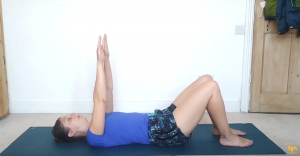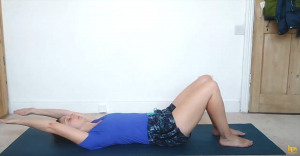One of the most common reasons clients come to our Pilates studio is because of back pain. There are so many different causes of back pain that it’s impossible to pinpoint exactly where it stems from. For some people it might be their day job which is heavily desk-based and leading to bad posture. For others it might be they are on the go non-stop and putting their spine through all sorts without adequate support from their core. Recovering from spinal surgery is another one, though I’d say camping or gardening are two of the most commonly quoted causes!
Whether you fall into one of those categories or not, chances are you have suffered from back pain at some point, or still do so now. The term ‘back pain’ can also mean a great many different things to different people, it’s an incredibly general term for something that is usually so specific to the individual. So before we start selling the benefits of Pilates for helping with back pain, let’s delve a little deeper.
Disclaimer
The first and most important thing to say is that Pilates teachers are not healthcare professionals. We can not diagnose your back pain. If someone comes to our studio and they are in pain, or movement causes them pain, then we would send them off to see a doctor, physio, osteo or chiropractor to get a proper diagnosis and treatment plan before agreeing to teach them. We then work closely with that professional to make sure the exercises we do are appropriate.
The rest of this post assumes that someone is coming to us after being signed off for exercise by a healthcare professional.
What do we mean by ‘back pain’?
Pain is completely subjective and no one else can tell you what you’re feeling. Sometimes using a scale of 1-10 can help. In a chat with a client we might ask them the following questions:
- Is it worse in the morning or the evening?
- Are there certain movements that trigger it?
- Where in the body do you feel it?
Questions 1 and 2 are particularly important as if pain is worse in the morning it suggests that being imobile during sleep causes stiffness that triggers pain and that movement throughout the day lessens it. While if the pain is worse in the evening then it suggests moving is actually making it worse – unless you’re in a posture that’s not conducive throughout the day. Question 3 often surprises people but they forget that your back is a large area. Our instant response is to imagine someone with back pain clutching their lower back like in the photo at the top, but quite often it’s the middle or upper back causing grief.
- Do you want to bend forwards to stretch it or backwards?
Both of these images are common to us. Back pain is so commonly indicated as someone arching their back with a hand to the lower back, or their back ‘going’ in a bent forward position. For Pilates teachers this question is really useful as it tells us what feels good to your body and what doesn’t, which suggests where there might be tightness or mobility issues.
Words
What we try to avoid is specific descriptive terms such as ‘sharp’, ‘burning’ or ‘dull ache’. This is because it becomes very hard to describe your pain in your own words if someone has already suggested something to you. Instead we might ask “what words would you use to describe your back pain?”.
Get moving!
What we also try to avoid is going on about it too much! If you’re otherwise healthy and haven’t been given any reason by a healthcare professional why you shouldn’t do Pilates then the best thing is to get you moving. If we spend too much time talking about your back pain then you can be sure it will start to feel worse. We’ve asked the questions to get a general idea of how your spine likes to move and how you might react to certain movements, now it’s time to let your body do the talking.
Why Pilates is good for healing back injuries
Pilates is all about balance, and I don’t mean just standing on one leg. It’s about balancing stability and mobility, drawing into your centre while reaching out long with your arms and legs, keeping control of the body while flowing through movement. When there is pain in the body there is something not quite balanced correctly. Pilates always works the whole body, never one element in isolation. You might think your back pain is due to a lack of abdominal strength and want to do hundreds of crunches, but it might actually be to do with tightness in your hips or tension in your shoulders. As Pilates teachers we are going to look at your body as a whole, not just the bit that you think needs improvement.
As someone new to Pilates you’ll start by learning the fundamentals. This series of exercises teaches you how to use your core muscles (abdominals, back, glutes and inner thighs) to stabilise your body. This means when you want to twist your spine or reach out with your arms and legs you’re doing it from a place of control, rather than letting your body decide where to move from.
An example exercise
To give you an example, one fundamental exercise is called Ribcage Arms.
- You lie on your back with your knees bent and feet flat on the floor.
- Your arms come up above your chest so your fingers point at the ceiling.
- The movement is then to take your straight arms behind you towards the floor, then return them to point at the ceiling.

What we see in many people is as soon as their arms start to go back their ribs lift up off the floor which makes their back arch. To put this in a real life situation, they’d raise their arms to lift something off a high shelf and to do so would stick their ribs out and arch their back. It might be that when you arch your back without thinking about it, that’s when you get a muscle twinge that causes you to grimace for the next few days whenever you move.
So, what we teach in Ribcage Arms is to:
- Soften the ribs down to the floor
- Only take the arms as far as you can maintain that connection with their ribs
- It is the core muscles working to maintain that connection and keep the back in a neutral position.

This is a great example of how small and subtle some of the Pilates exercises can be, but how they can achieve big results in improving how you control and move your body.
Will my back hurt during or after Pilates?
To begin with, Pilates is gentle. That doesn’t mean it’s not doing anything (as mentioned above, it’s subtle but powerful). Even gentle Pilates, however, might get you using muscles or moving in a way that you haven’t done for quite some time. This could cause some aches in the following days but it’s usually the good sort of ache that shows you’ve moved! During Pilates you will usually feel some work going on in the core muscles and certainly as you progress and we work you harder feeling ‘the burn’ is completely normal.
Often if you’re recovering from an injury or surgery you might feel some nervousness and hesitation about moving in case it causes you pain. It might. But you can rest assured that your teacher will always be watching and ready to stop or change the exercise if they don’t think it’s right for your body. In a 1:1 environment you can go at your own pace and work closely with your teacher to figure out the exercises that are most effective for getting movement and strength into your body. Even in a class environment it’s very common for a teacher to give one client a variation of an exercise so they can stay with the class but do what’s right for them.
This is why at our studio we always do a consultation before you start 1:1s or classes. It gives us the chance to get to know you and your body so your teacher can ensure you’re getting the most out of your Pilates.



